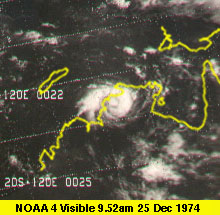Tropical Cyclone Tracy
| Category 4 severe tropical cyclone (Aus scale) | |
|---|---|
| Category 3 (Saffir–Simpson scale) | |

Cyclone Tracy near Darwin landfall
|
|
| Formed | 21 December 1974 |
| Dissipated | 26 December 1974 |
| Highest winds |
10-minute sustained: 175 km/h (110 mph) 1-minute sustained: 205 km/h (125 mph) Gusts: 240 km/h (150 mph) |
| Lowest pressure | 950 hPa (mbar); 28.05 inHg |
| Fatalities | 71 |
| Areas affected | Tiwi Islands, Darwin, Northern Territory |
| Part of the 1974–75 Australian region cyclone season | |
Cyclone Tracy was a tropical cyclone that from Christmas Eve to Christmas Day, 1974, devastated the city of Darwin, Northern Territory, Australia. It is the most compact cyclone or equivalent-strength hurricane on record in the Australian basin, with gale-force winds extending only 48 kilometres (30 mi) from the centre and was the most compact system worldwide until 2008 when Tropical Storm Marco of the 2008 Atlantic hurricane season broke the record, with gale-force winds extending only 19 kilometres (12 mi) from the centre. After forming over the Arafura Sea, the storm moved southwards and affected the city with Category 4 winds on the Australian cyclone intensity scale, while there is evidence to suggest that it had reached Category 3 on the Saffir-Simpson Hurricane Scale when it made landfall.
Tracy killed 71 people, caused A$837 million in damage (1974 dollars), or approximately A$6.41 billion (2014 dollars). It destroyed more than 70 percent of Darwin's buildings, including 80 percent of houses. Tracy left more than 41,000 out of the 47,000 inhabitants of the city homeless prior to landfall and required the evacuation of over 30,000 people. Most of Darwin's population was evacuated to Adelaide, Whyalla, Alice Springs and Sydney, and many never returned to the city. After the storm passed, the city was rebuilt using more stringent standards "to cyclone code". Bruce Stannard of The Age stated that Cyclone Tracy was a "disaster of the first magnitude ... without parallel in Australia's history."
...
Wikipedia
